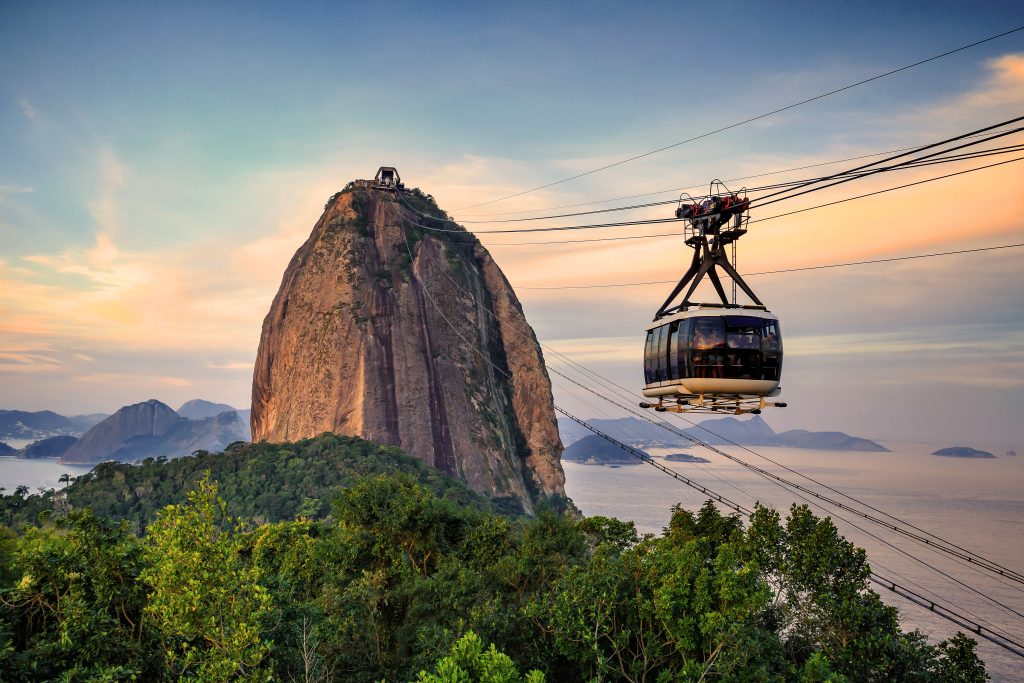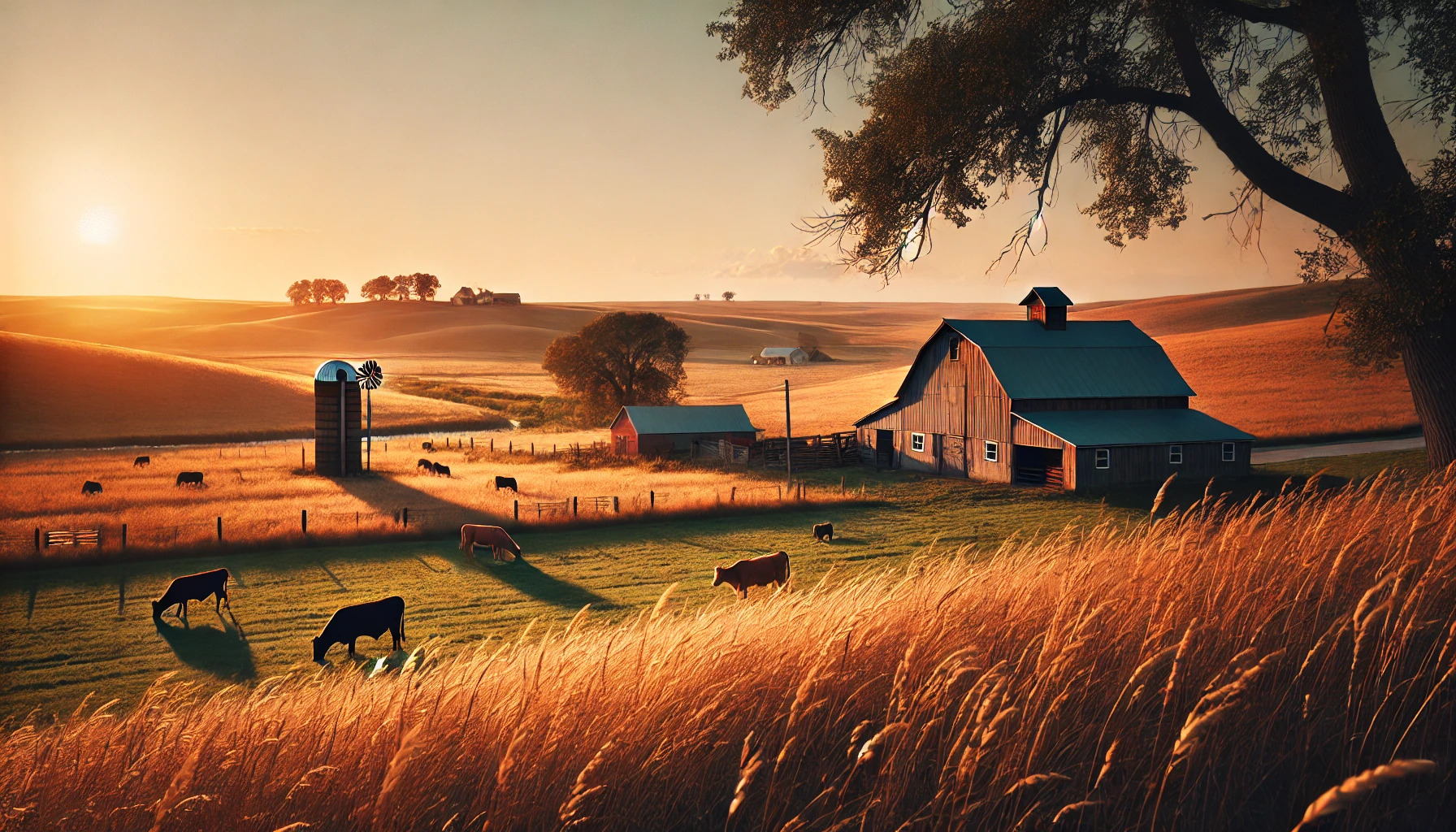Ah, Rio de Janeiro. A marvelous city, beaches that look straight out of a movie, and a view that honestly makes you question if the sky is always that blue. And right in the middle of all this, stands one of the city’s most iconic attractions: Sugarloaf Mountain. A giant granite monolith that not only defines the Carioca skyline but also serves as the perfect backdrop for a photo that will have your friends in a panic, asking how you manage to look so photogenic.
What is Sugarloaf Mountain?
Well, Sugarloaf Mountain isn’t exactly a gourmet snack served at Rio’s beaches (spoiler: that would be a terrible idea!). In fact, it’s a huge granite peak about 396 meters high, located at the entrance of Guanabara Bay. And no, it wasn’t sculpted with precision by a chef, but rather, was naturally formed millions of years ago.
The name “Sugarloaf” came about because the shape of the mountain resembled the old molds used to shape sugar in the 19th century. Imagine that? Your tourist excursion could have been called the “Sugar Tour!” – but apparently, the historical name was a bit more sophisticated.
How to Get to the Sugarloaf?
Getting to the top of Sugarloaf Mountain is almost as thrilling as any Hollywood action scene, without the explosions or high-speed chases. The main access is via the iconic cable car, a sleek, transparent cabin that takes you from one peak to the other, starting at the Urca Hill. Along the way, you’ll get spectacular views of Guanabara Bay, Santa Catarina Island, Rio, and Copacabana Beach. Spoiler alert: Your photos will be epic.
For the more adventurous (or for anyone who wants to star in their own action movie), there’s also the option to hike to the top, but be prepared for the heat and the steep climb. It’s not for the faint of heart!
What to See Up There?
After making your Instagram shine with that perfect shot of Rio down below, you can enjoy the 360-degree panoramic view. On one side, you’ll see Christ the Redeemer with arms wide open, embracing the city with an aura of peace (and a little bit of drama, if you think about it). On the other side, the sea and the beaches of Rio invite you to reflect on what it means to be a mere mortal in the face of such grandeur.
Now, the question is: how could anyone not take a photo of this? The views are breathtaking (but safely so, because you’ll be wearing a cap and sunglasses, looking all stylish).
Tips for Photographing Sugarloaf Mountain
- Golden Hour: The light at the end of the day is your best friend. The sun sets behind Rio, and the view turns magical, with vibrant colors in the sky. Get ready for that cinematic shot with perfect lighting.
- Unique Perspectives: Instead of a traditional photo of Sugarloaf, how about including the bay, the city, or even the cable car in the shot? A photo of the cable car going up can result in a dynamic and impressive frame.
- Urban vs. Nature Contrast: Rio is a unique blend of nature and city. Take advantage of this to capture the contrast between the concrete jungle and the green mountains. It’ll be hard not to take great photos.
Fun Facts You Didn’t Know About Sugarloaf Mountain
- The first cable car to reach the top of Sugarloaf was inaugurated in 1912. Imagine that! Cutting-edge technology… for its time.
- During World War II, the mountain was used as a lookout point for spotting ships. That’s right – you’re standing in a spot that’s part of a much more serious past, almost like a spy movie.
- Sugarloaf is, in fact, one of the most visited tourist spots in Rio, and it can be as popular as a concert by your favorite band (without the stress of the line).
Conclusion
Sugarloaf Mountain is undoubtedly one of Rio de Janeiro’s most unforgettable destinations. Whether it’s for capturing the view, taking a leisurely walk, or simply enjoying nature and the city from a different angle, you’ll find something memorable. And, like any great tourist attraction, it delivers – not only a beautiful image for your Instagram but also a unique experience. If you haven’t visited yet, it’s time to add this icon to your itinerary!
So, grab your camera (or just your phone, because who doesn’t love a good selfie?), and it’s off to conquer the Sugarloaf!

Christ the Redeemer: The Guardian of Rio and the Icon that Conquers Hearts Around the World
If Rio de Janeiro had a superhero, it would definitely be Christ the Redeemer. Not just because it’s gigantic, imposing, and, well, a symbol of power (but with peace and love in its heart). It’s because it represents everything Rio is: a mix of natural majesty and deep spiritual connection. If you’re planning a visit to the Marvelous City, Christ the Redeemer is not just a must-see – it’s practically the top of any tourist bucket list.
What is Christ the Redeemer?
Christ the Redeemer is a 30-meter-tall statue with arms wide open, located at the top of Corcovado Mountain, 710 meters above sea level, in the Tijuca National Park. The statue was inaugurated in 1931 and has since become one of Brazil’s and the world’s greatest icons. Imagine this: a gigantic figure of Jesus Christ, looking over the city, with the sea in the background and Rio at its feet. It’s more than a monument – it’s a symbol of faith, welcome, and hope.
The statue was designed by the artist Carlos Oswald and built with the help of engineer Heitor da Silva Costa. Its open-arm design is meant to represent divine embrace and protection, as if offering a giant hug to the Carioca people and tourists who visit Rio. And no, it’s not just waiting to take a selfie with you (but, honestly, it makes for a great photo op).
How to Get to Christ the Redeemer?
If you think you’ll need a hang-glider or some crazy mode of transportation, don’t worry! Getting to Christ the Redeemer is a pretty accessible experience, with various options for all types of adventurers.
- Corcovado Train: For a classic and very touristy experience, the train that climbs up Corcovado is the most popular choice. The ride is smooth, and the view of the city as you ascend is breathtaking (no exaggeration here). It’ll be hard not to snap several photos before even reaching the top.
- Christ the Redeemer Vans: Another comfortable option is the van service that takes visitors up to the top. It’s quicker and also has guides who share interesting facts as you go.
And for the more audacious, if you want a unique and challenging experience, you can hike up to the top, but be warned: it’s not an easy climb and requires physical preparation (not to mention the Rio heat, which can be relentless). Only for the truly fearless!
What to Do at Christ the Redeemer?
Alright, you’ve made it, Christ the Redeemer is standing tall before you, with arms wide open, offering a panoramic view of Rio. Now, what do you do? Well, besides taking some breathtaking photos (that’ll make your friends jealous), take a moment to reflect on the meaning of the place. Christ the Redeemer is a symbol of peace, welcome, and faith, and being up there with this magnificent view will give you a truly unique sense of tranquility.
And of course, don’t forget to explore the different perspectives of the city from up top. Christ offers an incredible view of Guanabara Bay, Copacabana Beach, Ipanema Beach, and even the Tijuca Forest. The photos here are simply spectacular.
Tips for Photographing Christ the Redeemer
- Golden Hour: The sunset is, without a doubt, the best time to capture Christ with the golden light illuminating the city. The colors of the sky are stunning, and Christ looks even more majestic.
- Creative Perspectives: Try capturing Christ from different angles, focusing on the grandeur of the statue and the beauty of Rio in the background. Photos that include the entire city can be incredible!
- Don’t Forget Yourself!: Of course, you’ll want to take the famous selfie with Christ in the background. But beyond that, how about an artistic shot, focusing on a detail of the statue or the expressions of people around?
Fun Facts About Christ the Redeemer
- One of the New Seven Wonders of the World: In 2007, Christ was named one of the New Seven Wonders of the Modern World, a title that truly reflects the impact it has, both for Brazilians and international tourists.
- Complex Construction: The construction of the statue took 5 years (between 1926 and 1931), and it was a challenging project, especially due to the difficulty of transporting materials to the top of Corcovado.
- Climate Immunity: Christ the Redeemer is a true warrior against the weather! Its construction was designed to withstand strong winds and even rain. And yes, it’s been struck by lightning during storms but always stands firm and strong.
Conclusion
Visiting Christ the Redeemer is a unique experience, both spiritual and visual. It’s the kind of place where you feel the grandeur of nature and the energy of a symbol that transcends time and borders. More than just a visit, it’s a chance to connect with the soul of Rio de Janeiro and reflect on what makes this city so special. If you haven’t been yet, it’s time to add this icon to your itinerary!
So, grab your camera (or just your phone, because we know you’ll want to capture the moment), and head for Christ the Redeemer – a divine hug from Rio de Janeiro awaits you at the top!

Ipanema Beach: The Carioca Style in Every Grain of Sand
When we think of Rio de Janeiro, many images come to mind: Christ the Redeemer with its arms wide open, Sugarloaf Mountain dominating the bay, and of course, Ipanema Beach. This little piece of paradise is not just one of Brazil’s most famous beaches, but also a global icon of style, culture, and contagious energy. If you’re planning a visit to the Marvelous City, you can’t ignore Ipanema. The beach that has been the setting for songs, movies, and historic moments offers something much deeper than just sand and sea.
What Makes Ipanema Unique?
Ipanema Beach is not just an ordinary beach. It’s a true cultural reference, with a carefree, sophisticated vibe that’s always full of life. Located in the South Zone of Rio, between the neighborhoods of Leblon and Arpoador, Ipanema is a place where Cariocas celebrate their identity, and visitors feel the energy of this unique mix.
Here, the golden sands are as iconic as the famous Copacabana sidewalk (but with a touch of class, of course!). Ipanema is the place where the sea meets the mountains, and where people come together to chat, sunbathe, or simply enjoy the moment.
The Music and Charm of Ipanema
Nothing defines Ipanema better than the classic song by Tom Jobim and Vinícius de Moraes: “Garota de Ipanema.” The song, which became one of the greatest Brazilian classics, captured the soul of the beach and the city. Who hasn’t heard that smooth melody and imagined themselves walking along the beach, feeling the sea breeze and the Carioca rhythm? What seemed like a simple compliment to a beautiful girl turned into an anthem of beauty and charm that transcends generations.
Ipanema is also the perfect stage for live bossa nova shows, popular music, and even the sounds of street vendors mixing tunes and rhythms. Every corner of the beach seems to have its own playlist, reflecting the diversity and laid-back spirit of the Carioca people.
What to Do in Ipanema?
In Ipanema, you won’t have trouble finding something to do – just go with the flow and the energy of the beach. Here are some must-do options:
- Walk Along the Sidewalk: The famous Portuguese-tile sidewalk, with its distinct curves and lines, is a true work of art. It’s the perfect spot for a walk by the sea while observing the beach’s activity and the waves gently breaking.
- Sun and Sea: Like any Brazilian beach, Ipanema is the ideal place to soak up the Rio heat and cool off in the sea. The waves are perfect for a good surf session or just a relaxing dip. And of course, if you’re looking for a good spot to get a tan, the beach is divided into “postos” (lifeguard stations), each with its own unique vibe. From Posto 9, known for its laid-back style, to Posto 10, which has a more family-friendly atmosphere, there’s a part of Ipanema for every taste.
- Shopping and Bar-Hopping: After a day in the sun, why not visit the trendy stores and charming bars of Ipanema? Rua Visconde de Pirajá offers a variety of shops selling clothing, accessories, and local crafts. For a more complete experience, you can enjoy a drink at one of the seaside bars and try a caipirinha or typical snacks like shrimp pastel and codfish cakes.
- Sunset at Arpoador: If you think the beauty of Ipanema is only during the day, think again. The sunset from Arpoador, a rock formation between Ipanema and Copacabana, is one of the most famous in Rio. As the sun sets over the sea, you’ll understand why Rio is one of the most desired places on the planet.
Ipanema: A Way of Life
Ipanema is more than just a beach – it’s a way of life. From the girls and boys of Ipanema to the tourists who fall in love with the city, everyone shares a spirit of freedom, relaxation, and joy. The beach reflects the Carioca, who values the present moment, good company, and the beauty of simplicity.
Ipanema is also a place where people connect – whether through a game of beach soccer, chatting at a kiosk, or playing beach volleyball. Life on the beach is a constant celebration of movement, whether in the body, in music, or in the flow of energy.
Fun Facts About Ipanema
- The Name “Ipanema”: The name “Ipanema” comes from the Tupi-Guarani language and means “bad water” or “place of bad waters.” But don’t worry – the waters of Ipanema are wonderful! The original name, however, referred to areas with waters not suitable for navigation, but nothing that could diminish the charm of the beach.
- Posto 9: The famous Posto 9 is known for its more relaxed and alternative atmosphere, being a gathering spot for the younger and more laid-back crowd, as well as for live music.
- Cultural Reference: Ipanema Beach and its sidewalk are frequently photographed and filmed, becoming a true cultural reference in movies, TV shows, and in Carioca fashion.
Conclusion
Ipanema Beach is more than just a tourist destination – it’s a celebration of the Carioca spirit. With its crystal-clear waters, stunning landscapes, and vibrant culture, Ipanema is the place where you can lose yourself in the moment, without haste, absorbing the energy of the city and the relaxed way of life in Rio. If you haven’t been yet, it’s time to put Ipanema at the top of your list – because, as the anthem of the beach says, “Girl from Ipanema, I’m going to fall in love!”

Avenida Paulista: The Beating Heart of São Paulo
If there’s one avenue that embodies the soul of São Paulo, it’s undoubtedly Avenida Paulista. One of the city’s largest and most important landmarks, it’s not just a major traffic route but also a hub of culture, history, and social life. It’s no wonder this avenue has become one of Brazil’s most iconic urban symbols, with its mix of modernity, history, and diversity.
What Makes Avenida Paulista Special?
Avenida Paulista is not just a street – it’s the backbone of São Paulo, connecting different neighborhoods and communities, while pulsating with a unique energy. With its 2.8 kilometers of length, it stretches from the elegant Paraíso to the lively Consolação, cutting through the heart of the city with its impressive architecture and cosmopolitan atmosphere.
It has everything: towering buildings, cultural centers, renowned museums, a wide variety of restaurants to please every palate, and of course, a spectacular view of Paulistano life, with its frenetic pace and innovative vibe.
History of Avenida Paulista
Inaugurated in 1891, Avenida Paulista started as a high-end residential area, primarily aimed at São Paulo’s elite at the time. Over the years, the avenue underwent a radical transformation, keeping pace with the growth and modernization of São Paulo. Today, it’s impossible not to notice the blend of modern skyscrapers and the old mansions that have withstood the test of time.
Throughout the 20th century, the avenue began to house companies, financial institutions, and cultural centers, becoming a symbol of economic power and influence in the country. It’s no surprise that it’s considered one of the most important avenues in Latin America, serving as a business hub and a highly sought-after tourist destination.
What to Do on Avenida Paulista?
When you think of Avenida Paulista, what comes to mind? The answer should be: a lot of things! The avenue is a true microcosm of São Paulo, where modernity meets history, and urban chaos blends with moments of tranquility. Here are some must-do activities for anyone visiting the avenue:
- Museums and Cultural Centers:
- MASP (São Paulo Museum of Art): With its iconic architecture and world-class collection, MASP is one of the largest art museums in Latin America. Located at number 1578 on the avenue, the museum offers permanent and temporary exhibits from renowned artists, along with one of the most amazing views of São Paulo.
- Casa das Rosas: A space dedicated to literature and culture, with classic architecture and a charming garden. Casa das Rosas hosts cultural events, exhibitions, and literary presentations that capture the intellectual spirit of the city.
- Centro Cultural Fiesp: Offering free cultural events such as art exhibits, theater, and film, Centro Cultural Fiesp is a must-visit for anyone looking to immerse themselves in São Paulo’s arts and culture.
- Strolls and Shopping: The Paulista sidewalk is perfect for those wanting to explore São Paulo’s urban life. With various shops, cafes, and malls like Shopping Pátio Paulista and Shopping Center 3, you can spend hours strolling between windows or stop for a coffee at one of the charming cafés along the avenue.
- Parks and Relaxation: Despite being a bustling urban center, Avenida Paulista has spaces for those seeking a break from the hustle and bustle. The Trianon Park, located right in the middle of the avenue, offers a green respite between the skyscrapers and is a great place to relax, take a walk, or simply enjoy nature.
- Nightlife: When the sun sets, Avenida Paulista takes on a new life. With an abundance of bars, restaurants, and nightclubs, the avenue offers a diverse nightlife scene. From sophisticated bars to more alternative and laid-back spaces, there’s something for everyone’s taste.
Avenida Paulista and Its Culture
Avenida Paulista is also a true cultural stage. It’s the meeting point for artistic expressions, festivals, and events that involve the entire city. On Sundays, the avenue transforms into an open space for the public, with the MASP Art and Antiques Fair and other outdoor activities. Additionally, it is one of the largest centers for political events and demonstrations in Brazil, bringing people from all walks of life into a democratic space for expression.
Another important point is the LGBT Pride Parade, which takes place annually on the avenue and is one of the largest celebrations of diversity and inclusion in the country, bringing visibility and support to the LGBT+ community in one of the world’s largest urban centers.
Fun Facts About Avenida Paulista
- Avenue of the Future: Originally, Avenida Paulista was planned to be an avenue of the future, being one of the first to have wide sidewalks, trees planted, and modern infrastructure for its time.
- São Paulo’s First Skyscraper: The first skyscraper in São Paulo, the Edifício Paulista, was inaugurated on Avenida Paulista and symbolized the city’s rise as a modern metropolis.
- Vibrant Culture: The avenue reflects São Paulo’s culture, a melting pot of influences from all over the world. It’s not uncommon to see street artists, musicians, and performers scattered along the avenue, making it even more vibrant.
Conclusion
Avenida Paulista is much more than just a street. It is a reflection of what São Paulo represents: a dynamic city, full of contrasts, rich in culture and history, with an energy that never stops. Walking along this avenue, you experience the essence of the city, where the past and the future meet in a unique way.
So, the next time you’re in São Paulo, don’t forget to take a stroll down the avenue. After all, Avenida Paulista is where you’ll find the true soul of the city: bustling, diverse, and timeless.

Batman Alley: São Paulo’s Urban Art Gallery
If you’re a fan of urban art or simply love exploring unusual places, Batman Alley in Vila Madalena, São Paulo, should be on your must-visit list. This alley, which feels more like an open-air gallery, is a true symbol of Brazilian creativity and graffiti, attracting both tourists and locals looking for an immersion in the street art universe.
The Origin of Batman Alley
The name “Batman Alley” has an interesting story. In the 1980s, a graffiti of the famous DC Comics character appeared on one of the alley’s walls, sparking the interest of local artists. The location, initially just a simple passageway, soon transformed into a meeting spot for graffiti artists and street creatives who began adding their own works to the walls.
Over time, the fame of Batman Alley grew, and it became an iconic place for urban art in São Paulo, gaining worldwide recognition as a space where art and culture come together in a free and spontaneous way.
What to Expect at Batman Alley
Batman Alley is not just a simple alley. As you walk through its narrow passages, you’ll encounter vibrant graffiti and colorful murals ranging from psychedelic images to more abstract illustrations, influenced by cubism, pop art, and much more. Every wall in the alley tells a story, and the art is constantly evolving, with new pieces being added regularly.
What’s most fascinating about Batman Alley is the interactivity it provides. At any moment, you can see artists working, painting, or recreating their own works. This constant renewal means that every visit offers a unique experience, as the art is never “frozen” and always changing, reflecting the dynamic nature of the city.
How to Get to Batman Alley
Located in the charming Vila Madalena neighborhood, Batman Alley is easily accessible from anywhere in the city. You can reach it from the Clínicas Metro Station and then walk for about 15 minutes to the location. There are also several bus lines that serve the area, making access even easier.
Batman Alley is open 24 hours a day, and as an open-air art gallery, you can visit at any time. However, to fully enjoy the atmosphere and capture great photos, it’s recommended to visit during the day, when natural light enhances the vibrant colors of the artwork.
Tips for Making the Most of Your Visit
- Best time to visit: If you want to avoid crowds, the best time is early in the morning on weekdays. This ensures a quieter experience, allowing you to appreciate the art at your own pace.
- Safety and precautions: While Batman Alley is a popular and generally safe tourist destination, it’s always good to keep an eye on your belongings, as you would in any major city. Avoid displaying valuable items and keep your possessions close.
Beyond the Alley: Explore Vila Madalena
Vila Madalena is a neighborhood full of culture, cool bars, amazing restaurants, and art studios. After visiting Batman Alley, take the opportunity to explore the surrounding area and get lost in its charming streets full of history. Don’t forget to check out the art shops and galleries that make the area a true cultural hotspot.
Conclusion
Batman Alley is not just any alley – it’s a celebration of urban art, where every corner and wall offers something new. On every visit, you can discover different interpretations of art, colors, and shapes, reflecting the diversity and creative freedom that define São Paulo’s identity.
If you haven’t visited Batman Alley yet, now is the perfect time to explore this vibrant part of the city. Get ready to lose yourself in the colors and forms and experience street art in its most authentic form!

Ibirapuera Park: The Green Heart of São Paulo
If you think São Paulo is all skyscrapers, honking horns, and rushed espressos… then you clearly haven’t taken a proper stroll through Ibirapuera Park. This lush oasis in the middle of urban chaos is the perfect escape for those wanting to disconnect, soak up the sun (without getting run over by a motorcycle), and maybe even absorb some culture while they’re at it.
A Park with a History (and a very curious name)
Opened on August 21, 1954, Ibirapuera Park was created to celebrate São Paulo’s 400th anniversary. And yes, the name is a bit… unique. “Ibirapuera” comes from the Tupi-Guarani language and means “rotted tree.” Not exactly poetic — but it couldn’t be more ironic considering how stunning the place has become.
Before it was the iconic landmark it is today, the area was basically a swamp. In the 1920s, Australian eucalyptus trees were planted to dry out the land and prep it for what would eventually become the city’s most beloved park.
Art… in the Middle of Nature!
Ibirapuera Park is not just pretty — it’s artsy. You’ll find exhibitions, stunning architecture by Oscar Niemeyer, and more inspiration per square meter than a TED Talk playlist. Here are some must-sees:
- Museum of Modern Art (MAM): A favorite among São Paulo’s art crowd, featuring modern and contemporary works, plus workshops that’ll make you feel at least 37% more cultured.
- Ibirapuera Auditorium: That bold red acoustic shell? That’s where concerts and cultural events go down. Designed by Niemeyer, it’s the park’s visual mic drop.
- Professor Aristóteles Orsini Planetarium: Brazil’s first planetarium, offering stargazing and cosmic knowledge — perfect for pretending you understand constellations.
- Japanese Pavilion: A peaceful replica of Kyoto’s Katsura Palace. It’s got koi ponds, tea, and the kind of zen that makes you want to start writing haikus.
Nature That Hits Different
The park covers 1.5 km² and bursts with over 500 plant species and 300 animal species, including more than 200 types of birds. Basically, it’s National Geographic meets urban escape.
Whether you’re into yoga, rollerblading, biking, or the ancient art of doing absolutely nothing under a shady tree — Ibirapuera’s got you.
And yes, pets are welcome. Just… you know… pick up after your dog. We live in a society.
Fun for Everyone
- Bike paths and running trails: Perfect for pretending you’re training for a marathon.
- Playgrounds: For the kids to burn off energy — and for parents to test their patience.
- Cultural events: Home to the São Paulo Biennial, food festivals, concerts, and the occasional peaceful protest.
Fun Facts That’ll Impress at Dinner Parties
- In 2015, The Guardian named Ibirapuera Park one of the best parks on the planet. Yes. The planet. That’s how iconic it is.
- Before it even officially opened, it hosted Picasso’s “Guernica” during the 1953 Biennial. Casual.
Conclusion: Just Go. Seriously.
Ibirapuera Park is the kind of place that pleases everyone — from sunrise joggers to couples looking for a shady spot to smooch in peace. It’s art, culture, nature, and best of all… it’s free! (Which, in São Paulo, is practically a miracle.)
So if you find yourself in Brazil’s concrete jungle, grab your sneakers, a water bottle, and your best camera (or a podcast if you’re in chill mode). Ibirapuera is waiting — no ticket needed.

Ouro Preto, Brazil: Where History, Culture, and Cobbled Hills Meet
Discover the city where every stone tells a story, every church glows like gold, and every uphill climb feels like a journey through time (and a leg workout).
A Dive into Brazil’s Baroque Heart
Ouro Preto, in the state of Minas Gerais, is not just a travel destination — it’s a time machine disguised as a colonial town. Founded in the late 1600s, it became the epicenter of Brazil’s Gold Rush and still enchants visitors with its Baroque architecture, unforgettable cuisine, and a historical charm that only Minas can offer.
The Gold Capital of the 18th Century
Back in colonial Brazil, Ouro Preto was the place to be. Literally. It’s estimated that over 800 tons of gold were extracted from the region. The city’s name means “Black Gold” because the gold found there was coated with a dark layer of iron oxide. But underneath? Pure gold. The wealth was immense — and so was the cost, with slavery leaving deep scars in the city’s past.
Churches That Could Belong in Museums
Ouro Preto has more than 20 historic churches, and each one is an artistic and architectural masterpiece.
- São Francisco de Assis Church: designed by legendary artist Aleijadinho, with ceiling paintings by Ataíde — Brazil’s answer to Michelangelo.
- Nossa Senhora do Pilar: its interior features more than 400 kilos of gold. Yes, you read that right. GOLD.
- Others like Nossa Senhora do Carmo and Santa Efigênia add to the holy extravaganza.
Bring your camera and maybe a neck brace — you’ll be looking up a lot.
Culture, Art, and Youth on Every Corner
Despite its colonial look, Ouro Preto is lively, young, and full of events.
- The Ouro Preto Winter Festival is one of Brazil’s top cultural events.
- During Holy Week, the streets transform into colorful carpets made of flowers and sawdust.
- Thanks to the Federal University of Ouro Preto (UFOP), the city has a vibrant student vibe, with traditional “repúblicas” (student houses), parties, and an ever-creative energy.
Minas Cuisine: Delicious Motivation for Uphill Climbs
The only thing that can rival the city’s beauty is its food. Authentic Minas Gerais cuisine is hearty, comforting, and totally worth the calories.
- Dishes like tutu de feijão, feijão tropeiro, and chicken with okra
- Iconic pão de queijo — hot, cheesy, and divine
- Legendary sweets like doce de leite, goiabada, ambrosia, and of course, Minas cheese
Pro tip: climb first, eat later. Trust me — it’s safer.
Why Visit Ouro Preto?
- It’s a crash course in Brazilian history, no textbook needed
- It’s an open-air museum of Baroque art and colonial design
- It’s a sensory journey: taste, sight, sound, and sore calves
- And because you deserve a trip that feels like stepping inside a real-life painting
Final Thoughts: A City That Ages Like Fine Wine
Ouro Preto doesn’t need flashy lights or modern skyscrapers to impress. Its charm lies in its authenticity, its stories, and its unwavering presence as a guardian of Brazilian heritage. It’s the kind of place that makes you slow down, look around, and say: “Wow, I needed this.”
If you’ve already visited Ouro Preto, share your favorite memory in the comments — or the hill that almost took you out. And if you haven’t… what are you waiting for?

Serra do Cipó, Brazil: Where Nature Is Wild, Stunning, and Totally Instagrammable
Mountains, trails, waterfalls, and that irresistible “I quit everything and moved to the forest” vibe. Welcome to Serra do Cipó, one of Brazil’s most spectacular natural destinations.
A Natural Sanctuary Just Outside Belo Horizonte
Located about 100 km from Belo Horizonte, Serra do Cipó is a gem nestled in the Serra do Espinhaço mountain range — recognized by UNESCO as a biosphere reserve. Translation: it’s an ecological treasure trove full of wild beauty, off-the-grid adventure, and that sweet feeling of peace you didn’t know you needed.
The gateway to this paradise is the charming town of Santana do Riacho, which feels like a magical portal to trails, crystal-clear rivers, and the kind of comfort food that hugs you from the inside out.
Trails, Sweat, and Pure Reward: Must-See Attractions
At Serra do Cipó, fun comes with a side of hiking shoes, sunscreen, and determination. But don’t worry — this isn’t an Avenger-level mission. The payoff is always breathtaking scenery… sometimes literally, depending on the hill.
Farofa Waterfall
An 8 km round-trip hike leads you to this cinematic waterfall, perfect for swimming, picnics, or snapping that nature-loving profile pic.
Bandeirinhas Canyon
A dramatic geological wonder with towering rock walls that look hand-carved by Minas gods. The trail is longer (about 12 km round-trip), but the views are worth every drop of sweat.
Véu da Noiva (Bride’s Veil)
One of the most photogenic waterfalls in the region. The hike is easier, ideal for beginners or anyone wanting a more relaxed nature walk.
Lapinha Peak
For thrill-seekers and altitude lovers, Lapinha Peak offers panoramic views that make you forget Wi-Fi exists. Go at sunset — it’s pure desktop wallpaper material.
Biodiversity That Belongs in a Nature Doc
The area is basically a biology textbook in 3D. With cerrado vegetation, endemic plant species, and wildlife like maned wolves, armadillos, and the occasional bird show, Serra do Cipó is a dream come true for eco-tourists and nature nerds.
A large portion of the region is protected by the Serra do Cipó National Park, managed by ICMBio. So please, no littering — nature is letting you in, so don’t be rude.
Food, Cozy Inns, and Village Vibes
After all that hiking, it’s time to feast. Local restaurants serve up classic Minas Gerais dishes like feijão tropeiro, free-range chicken, and crunchy torresmo, all best enjoyed with a shot of artisanal cachaça (after hiking, please — don’t drink and climb).
The village offers charming accommodations ranging from laid-back hostels to romantic inns with fireplaces and hammocks. Whether you’re a couple, a family, or a solo traveler on a soul-searching mission, you’ll feel right at home.
Jarvis-Approved Survival Tips
- Proper shoes: Flip-flops are for chilling, not hiking.
- Bug spray & sunscreen: The forest is stunning but not always gentle.
- Snacks and water: Uber Eats does not deliver to waterfalls.
- Cell signal? Forget it. Embrace the offline life.
Final Thoughts: One Mountain, Endless Emotions
Serra do Cipó isn’t just a place — it’s an experience. Raw nature, pure beauty, and real peace. A reminder that sometimes, the best version of you is waiting on a trail somewhere between a waterfall and a good meal.
If you haven’t been yet, it’s time to add it to your list. And if you have, leave a comment about which trail made your heart race — or your legs regret it.

Mariana – The First of Minas: Where the Past Shines with Gold and Charm
If Minas Gerais were a constellation of historic cities, Mariana would be the brightest star to appear first. Founded in 1696, with that gentle and captivating Minas-style, Mariana isn’t just the state’s first capital — it’s a true national treasure nestled among mountains rich in history, art, and culture.
History with a Capital H (and a lot of gold)
Before it became Mariana, the city went by the name of Arraial de Nossa Senhora do Carmo — a name as big as its role in the gold rush. In 1745, it was elevated to city status and received a royal upgrade: it was named in honor of Queen Maria Anna of Austria. Yes, sir, a city born with noble blood and golden dust in its veins.
Baroque architecture that could make Da Vinci tear up
A simple stroll down its cobbled streets is like a free art history class. Minas Gerais Square (Praça Minas Gerais) is the city’s beating heart, where the twin churches — São Francisco de Assis and Nossa Senhora do Carmo — proudly display their breathtaking facades. And the old Town Hall and Jail looks on with the wisdom of someone who’s seen it all.
It’s not stuck in the past, thank you very much
Mariana knows how to mix vintage soul with modern vibes. The city invests in the creative economy and hosts events like the Economic Development Week, proving it’s not just about baroque beauty — it means business. Local street fairs keep traditions alive while boosting the economy, offering everything from handmade pottery to gourmet coffee.
Underground tourism: literally!
Think history is only above ground? Think again. Mariana invites you to look down — way down. The Passagem Mine, the largest gold mine open to visitors in the world, takes you 120 meters underground via a rail cart, straight into the heart of Brazil’s mining history. Spoiler: it’s as epic as it sounds.
Cuisine that comforts both the belly and the soul
You can’t leave Mariana without trying the real deal: authentic pão de queijo, artisan cachaça, and of course, a generous plate of feijão tropeiro that’ll make your stomach sing the national anthem. Minas cuisine is a treasure all its own — and in Mariana, every bite is a celebration.
A conclusion worthy of a movie soundtrack
If you’re looking for a place where the past isn’t just remembered but proudly celebrated, set your emotional GPS to Mariana. A city where every stone tells a story, every church holds a masterpiece, and every local has a warm “uai” ready to welcome you.
Mariana isn’t just the first of Minas. She’s the first in the hearts of those who visit.

Guarapari – The Capixaba Paradise Where the Sun Vacations With You
When Espírito Santo wants to show off, it sends Guarapari to the stage. Located about 50 km from the state capital Vitória, this coastal gem combines stunning beaches, therapeutic sands, and a warm welcome that makes every visitor consider quitting their job and never going home again.
Beaches for every taste (and swimsuit)
Guarapari is famous for having over 30 beaches — yes, thirty! And each has its own unique personality. Looking for action? Head straight to Praia do Morro. Prefer peace and a dreamy Instagram backdrop? Praia das Castanheiras awaits with calm waters and natural shade. Into diving or healing vibes? Praia da Areia Preta is your go-to spot. Known for its monazite-rich sands, this beach attracts visitors from all over Brazil thanks to its alleged therapeutic (not Hulk-inducing) radiation.
Healing sand, embracing sea
Speaking of Areia Preta, it deserves its own spotlight. The black sands of Guarapari are rich in rare minerals said to relieve joint pain and other ailments. It’s like the beach itself whispers, “Don’t worry, I’ve got your back… and knees too.”
Nightlife and cuisine: a delicious combination
By day, Guarapari is a seaside sanctuary. By night? It turns into a vibrant hub of bars, live music, and delicious seafood. The highlight? The legendary moqueca capixaba — a local fish stew that proudly does not include palm oil (a big deal around here, trust me). Fresh, flavorful, and full of love from the sea.
Tradition, culture, and small-town charm with an ocean view
Despite its popularity, Guarapari still feels like that friendly coastal town where everyone knows your name — or at least offers you a coconut. Locals are kind, traditional festivals are alive and well, and the city maintains its relaxed and charming personality all year round. In summer? The population triples, and the happiness does too.
A sun-kissed, salty-haired conclusion
Guarapari isn’t just a beach. It’s a lifestyle, a wellness retreat, and a feast for the senses all rolled into one. It’s that place you visit once… and immediately start plotting your return like it’s a secret mission.
So next time you’re planning a beach getaway in Brazil, remember: Guarapari is waiting for you with sandy feet, an open heart, and a moqueca on the stove.

Vitória – The Island Capital of Brazil That Looks Like a Postcard
If there were an Instagram filter called “Vitória,” it would have blue skies, sparkling sea, golden sunsets, and a faint aroma of moqueca in the air. Located on an island surrounded by beaches and mountains, Espírito Santo’s capital is a playground for photographers, influencers, and travelers whose camera rolls are always full — and proud of it.
1. Terceira Ponte – The Golden Hour’s Favorite Bridge
Ah, the Terceira Ponte (Third Bridge)! Connecting Vitória to Vila Velha, this iconic bridge becomes a golden catwalk for the sun every evening. Pro tip: hike up the Morro do Moreno (in Vila Velha) and snap that epic sunset shot with the bridge as your foreground hero. Frame it. Post it. Bask in the likes.
2. Convento da Penha – A Heavenly View (Literally)
Okay, technically it’s in Vila Velha, but the view of Vitória from the Penha Convent is nothing short of divine. Perched on a hill, it offers sweeping views of the city, the bay, and your own sense of inner peace. Go up, breathe deeply, give thanks… and take at least fifty panoramic shots.
3. Enseada do Suá and Praça do Papa – Urban Jungle Meets Ocean
If you like your cityscapes with a splash of sea breeze, the Praça do Papa is your spot. Think shimmering buildings, ocean views, mountains in the distance, and wide-open space for that perfect shot. Ideal for photoshoots, casual snapshots, or just flexing your travel game.
4. Pedra da Cebola Park – Zen, Rocks, and Perfect Lighting
Looking for something more peaceful and green? Pedra da Cebola Park blends nature, walking trails, and an onion-shaped rock that adds a mystical vibe to your photos. Whether it’s a spontaneous selfie or a meticulously staged couples shoot, this place delivers aesthetic gold.
5. Ilha das Caieiras – Culture, Boats, and Sunset with a Side of Seafood
Ilha das Caieiras is where you go when you want your photos to tell a story. Colorful boats, local fishermen, and floating restaurants that serve moqueca fresh from the sea — all wrapped in a warm sunset glow. Your camera will fall in love (and so will your stomach).
6. Metropolitan Cathedral – Sacred Drama in the City Center
If you’re going for gothic elegance or architectural drama, head to the Metropolitan Cathedral in the historic center. Majestic facade? Check. Stained glass windows? Check. Epic angles for moody shots? Triple check. It’s like Europe, but with palm trees and 100% Brazilian soul.
Conclusion: Vitória Knows She’s Photogenic – and She Owns It
Vitória isn’t just a destination. It’s a backdrop waiting to elevate your travel photography to Oscar-winning levels. Every corner is a frame, every sunset is a masterpiece, and every local could double as a friendly guide with a smile.
So whether you’re shooting with a high-end DSLR or a well-loved phone with a cracked screen, the truth is simple: Vitória is ready for her close-up — and your feed will thank you.









